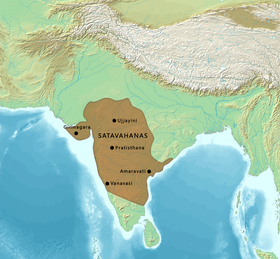Satavahana Empire | |||||||||||||||||||||
|---|---|---|---|---|---|---|---|---|---|---|---|---|---|---|---|---|---|---|---|---|---|
| c. 228 BCE–c. 224 CE | |||||||||||||||||||||
Approximate extent of the Satavahana Empire, in the early 1st century CE.[1] | |||||||||||||||||||||
| Capital | Pratishthana Amaravati | ||||||||||||||||||||
| Common languages | Prakrit Sanskrit (Rarely) | ||||||||||||||||||||
| Religion | Hinduism[2][3] Buddhism | ||||||||||||||||||||
| Government | Monarchy | ||||||||||||||||||||
| Raja | |||||||||||||||||||||
• 228–205 BCE | Simuka (first) | ||||||||||||||||||||
• 217–224 CE | Pulumavi IV (last) | ||||||||||||||||||||
| Historical era | Classical India | ||||||||||||||||||||
• Established | c. 228 BCE | ||||||||||||||||||||
• Disestablished | c. 224 CE | ||||||||||||||||||||
| |||||||||||||||||||||
| Today part of | India[4] | ||||||||||||||||||||
| Satavahana kings 100 BCE–2nd c. CE | ||||||||||||||||||||||
|---|---|---|---|---|---|---|---|---|---|---|---|---|---|---|---|---|---|---|---|---|---|---|
|
||||||||||||||||||||||
The Satavahanas (/ˌsɑːtəˈvɑːhənə/; Sādavāhana or Sātavāhana,[5] IAST: Sātavāhana), also referred to as the Andhras (also Andhra-bhṛtyas or Andhra-jatiyas) in the Puranas, were an ancient Indian dynasty. Most modern scholars believe that the Satavahana rule began in the late second century BCE and lasted until the early third century CE, although some assign the beginning of their rule to as early as the 3rd century BCE based on the Puranas, but uncorroborated by archaeological evidence. The Satavahana kingdom mainly comprised the present-day Andhra Pradesh, Telangana, and Maharashtra. At different times, their rule extended to parts of modern Gujarat, Madhya Pradesh, and Karnataka. The dynasty had different capital cities at different times, including Kotalingala (Telangana), Pratishthana (Paithan) and Amaravati (Dharanikota).
The origin of the dynasty is uncertain, but according to the Puranas, their first king overthrew the Kanva dynasty. In the post-Maurya era, the Satavahanas established peace in the Deccan region and resisted the onslaught of foreign invaders. In particular their struggles with the Saka (Western Satraps) went on for a long time. The dynasty reached its zenith under the rule of Gautamiputra Satakarni and his successor Vasisthiputra Pulamavi. The kingdom had fragmented into smaller states by the early 3rd century CE.
The Satavahanas were early issuers of Indian state coinage struck with images of their rulers. They formed a cultural bridge and played a vital role in trade and the transfer of ideas and culture to and from the Indo-Gangetic Plain to the southern tip of India.
- ^ Schwartzberg, Joseph E. (1978). A Historical atlas of South Asia. Chicago: University of Chicago Press. p. 145, map XIV.1 (e). ISBN 0226742210.
- ^ Sinopoli 2001, p. 172.
- ^ "The Satavahana Phase". academic.oup.com. Retrieved 29 October 2022.
- ^ K.M., Dayashankar (26 September 2014). "Koti Lingala, a major pilgrim destination". The Hindu. Retrieved 25 February 2020.
- ^ Cite error: The named reference
auto3was invoked but never defined (see the help page).



